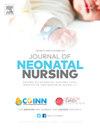Does normothermia in the delivery room predict NICU admission normothermia?
Q2 Nursing
引用次数: 0
Abstract
Background
Normothermia during the first hour of life improves neonatal outcomes. Temperature is routinely assessed on admission to NICU, but the optimal time and method of assessing temperature after birth is not known.
Aim
Determine whether diagnosis and treatment of hypothermia in the Delivery Room/Operating Room (DR/OR) decreases NICU admission hypothermia. We hypothesized that infants’ post-stabilization temperature in the DR predicts NICU admission temperature, and that axillary temperatures correlate adequately with rectal measurements.
Methods
Newborn axillary temperatures were obtained in the DR/OR from March 2020–September 2021. Medical teams were instructed to perform standard interventions based on the unit's “hypothermia prevention bundle” and to achieve and document normothermia before departure from the DR/OR if possible. Axillary and rectal temperatures were obtained on admission to the NICU within 1 h of birth (n = 445, including 331 with DR/OR measurements).
Results
DR/OR axillary temperature moderately correlated with NICU admission axillary temperature (Pearson coefficient 0.40, p < 00.0001). After adjusting for delivery mode, respiratory support, gestational age, and time between measurements, DR/OR axillary temperature remained significantly associated with NICU admission temperature (p < 0.0001). Axillary temperatures were, on average, 0.13 ± 0.35 °C lower than rectal measurements.
Conclusions
Our findings suggest that achievement of normothermia in the DR/OR immediately after initial resuscitation is feasible and may decrease NICU admission hypothermia. Quality improvement interventions to decrease NICU hypothermia should include assessment of temperature in the DR/OR. Axillary temperatures are good approximation of rectal temperatures, enabling repeated non-invasive measurements to facilitate normothermia in the DR/OR and on admission to NICU.
产房正常产血症是否预示新生儿重症监护病房入院正常产血症?
背景:出生后一小时内的正常体温可改善新生儿结局。新生儿重症监护病房入院时常规评估体温,但出生后评估体温的最佳时间和方法尚不清楚。目的确定产房/手术室(DR/OR)的低温诊断和治疗是否会降低新生儿重症监护病房入院时的低温。我们假设婴儿在DR中稳定后的体温可以预测NICU的入院温度,并且腋窝温度与直肠测量有充分的相关性。方法于2020年3月- 2021年9月在DR/OR中获取新生儿腋窝温度。医疗小组被指示根据该单位的“低温预防包”执行标准干预措施,并在可能的情况下在离开DR/OR之前实现并记录体温正常。在新生儿重症监护病房(NICU)出生后1小时内获得腋窝和直肠温度(n = 445,其中331有DR/OR测量)。结果dr /OR腋窝温度与新生儿重症监护病房入院腋窝温度中度相关(Pearson系数0.40,p <;00.0001)。在调整分娩方式、呼吸支持、胎龄和测量间隔时间后,DR/OR腋窝温度仍与新生儿重症监护病房入院温度显著相关(p <;0.0001)。腋窝温度平均比直肠温度低0.13±0.35℃。结论初步复苏后立即在DR/OR实现体温正常是可行的,并可减少新生儿重症监护病房入院时的低体温。降低新生儿重症监护病房低温的质量改进干预措施应包括DR/OR的温度评估。腋窝温度很好地近似于直肠温度,可以在DR/OR和NICU入院时进行重复的无创测量,以促进正常体温。
本文章由计算机程序翻译,如有差异,请以英文原文为准。
求助全文
约1分钟内获得全文
求助全文
来源期刊

Journal of Neonatal Nursing
Nursing-Pediatrics
CiteScore
2.00
自引率
0.00%
发文量
143
期刊介绍:
Aims & Scope: This is the practical, bimonthly, research-based journal for all professionals concerned with the care of neonates and their families, both in hospital and the community. It aims to support the development of the essential practice, management, education and health promotion skills required by these professionals. The JNN will provide a forum for the exchange of ideas and information between the range of professionals working in this field; promote cooperation between these professionals; facilitate partnership care with families; provide information and informed opinion; promote innovation and change in the care of neonates and their families; and provide an education resource for this important rapidly developing field.
 求助内容:
求助内容: 应助结果提醒方式:
应助结果提醒方式:


